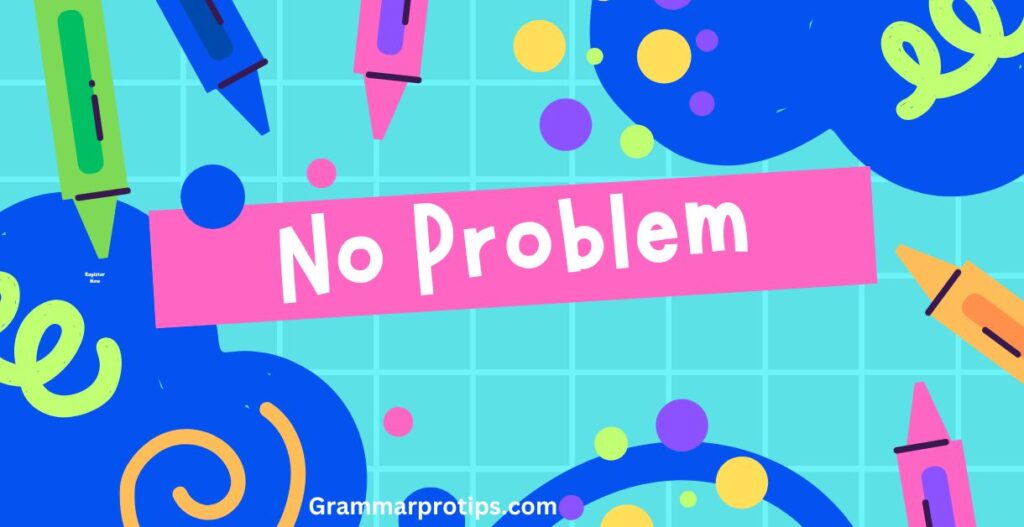In everyday conversations, both in professional and casual settings, we often find ourselves responding to a “thank you” with the phrase “no problem.” But while this phrase is perfectly fine, it can become repetitive and, at times, a little too informal. Sometimes, it’s better to use a variety of responses to keep the conversation flowing smoothly and sound more engaging.
1. “You’re Welcome”
Perhaps one of the most classic alternatives to “no problem,” “you’re welcome” is both polite and widely used. It conveys warmth and shows appreciation for the person who thanked you.
Example:
Scenario: You helped a colleague with a project deadline. They send you a message saying thank you.
Response:
“You’re welcome, Sarah! I’m happy I could assist. If you need anything else, don’t hesitate to reach out!”
This response not only acknowledges the gratitude but also opens the door for further help, keeping the tone friendly and professional.
2. “Not a Problem at All”
If you’re looking for something slightly more formal than “no problem,” “not a problem at all” works wonders. It sounds reassuring and conveys that you were more than happy to help.
Example:
Scenario: A client sends a message asking for last-minute changes to a presentation you prepared.
Response:
“Not a problem at all, Emily! I’ll make those adjustments right away and send the updated file shortly.”
This phrase is especially useful in professional communication, where you want to assure the other party that you’re on top of the task.
3. “Anytime”
This response has a friendly and laid-back vibe. Saying “anytime” shows that you’re open to helping again in the future, and it can even be used in casual or friendly settings.
Example:
Scenario: A friend thanks you for helping them move into their new apartment.
Response:
“Anytime, Lisa! It was fun helping you out. Let me know when you need another hand with unpacking!”
By using “anytime,” you’re expressing that your help is always available and that you are happy to assist in the future.
4. “My Pleasure”

If you want to sound gracious and polite, “my pleasure” is a fantastic choice. It has a professional tone but also adds a sense of personal satisfaction to your response.
Example:
Scenario: A customer service representative thanks you for your patience while they resolve an issue.
Response:
“My pleasure, Mr. Thomas! I’m glad we could sort everything out for you today. Please don’t hesitate to contact us again if you need further assistance.”
This phrase adds a touch of formality and respect while still conveying a willingness to help.
5. “Glad to Help”
“Glad to help” is a simple yet effective response that communicates positivity and a sense of readiness to assist.
Example:
Scenario: A colleague sends a quick thank you message for offering assistance with a report.
Response:
“Glad to help, Jack! I’m always happy to jump in whenever you need me.”
This phrase works perfectly in casual exchanges at work or with friends and conveys an open, approachable tone.
6. “No Worries”
“No worries” has become a go-to phrase in many English-speaking countries. It’s relaxed and informal, making it perfect for casual conversations or in environments where a more laid-back tone is appropriate.
Example:
Scenario: A teammate thanks you for covering their shift at work.
Response:
“No worries, Tim! It was no trouble at all. Hope you’re enjoying your day off!”
This is a great example of how to respond casually without sounding dismissive. It assures the person that their request wasn’t a burden.
7. “Of Course”

“Of course” can be used in both formal and informal contexts. It has a slightly more confident tone than “no problem” and conveys that helping the other person was a natural thing for you to do.
Example:
Scenario: A supervisor asks if you can send them the files for a presentation they need to review.
Response:
“Of course, Rachel! I’ll send those over right away. Let me know if you need anything else.”
This phrase makes the response sound gracious and proactive.
8. “Absolutely”
For a more enthusiastic or emphatic response, “absolutely” works wonders. It shows that you were happy to help and adds a positive, reassuring tone to your message.
Example:
Scenario: A friend thanks you for helping them fix their car.
Response:
“Absolutely, Mark! I’m glad I could lend a hand. Let me know if you need any more help with it in the future.”
This is a great alternative to “no problem” when you want to express a strong willingness to assist.
9. “Sure Thing”
A bit more informal but still widely used in friendly settings, “sure thing” has a relaxed and confident feel. It implies that you are happy to assist, no matter the task.
Example:
Scenario: A coworker asks if you can grab a coffee for them while you’re out.
Response:
“Sure thing, Daniel! I’ll pick up your usual. See you in a bit.”
This phrase works well in informal exchanges and conveys confidence while still sounding friendly.
10. “It’s No Trouble”
For situations that might seem slightly more formal or professional, “it’s no trouble” is a polite and reassuring way to respond to thanks.
Example:
Scenario: A client thanks you for handling their last-minute request.
Response:
“It’s no trouble at all, Mr. Lewis. I’m happy to assist whenever you need. Let me know if there’s anything else I can help with.”
This phrase is a great alternative expression in business communication, showing that you are both professional and accommodating.
Bonus: Other Phrases to Express “No Problem”

Aside from the 10 phrases above, there are several other alternatives that can work in various situations. Here’s a quick list of more ways to express “no problem”:
- “It’s nothing.”
- “I’m happy to help.”
- “Don’t mention it.”
- “It’s all good.”
- “Glad I could be of assistance.”
- “Consider it done.”
Scenario: Email Example for Professional Setting
Let’s say you’ve just helped a colleague with a difficult task at work. They send you a thank-you message, and you want to respond in a way that’s professional and warm. Here’s an email example:
Subject: Re: Thank You for Your Help
Hi David,
Thank you for your kind words! It’s no trouble at all. I’m always happy to support the team however I can. If you ever need assistance with anything else, just let me know. I’m happy to help anytime!
Best regards,
Jessica
In this example, the phrase “It’s no trouble at all” sounds professional and reassuring, while “happy to help anytime” leaves the door open for future collaboration.
Conclusion
Using different ways to say “no problem” in conversations or professional settings can help you communicate more effectively. Whether you’re looking to sound polite, casual, professional, or just a little more engaging, there are plenty of alternatives to fit the tone of your message.
Next time you find yourself responding to a “thank you,” try swapping out “no problem” for one of these phrases. Not only will it make your interactions sound more varied, but you’ll also come across as someone who knows how to communicate in a way that suits the situation.
So, whether you’re responding to a friend, colleague, client, or customer, remember: communication is key. And using the right phrases at the right time can make a world of difference.
Keywords used:
- happy for you synonyms
- i’m happy for you synonym
- another way to say i’m happy for you
- other ways to say i’m happy for you
- another way to say happy for you
- is no problem
- different ways of saying no problem
- example of a problem with no solution
- problems with no solution
- non example of problem and solution
- another way to say no worries professionally
- how to say no worries professionally in email
- no problem in text slang
- how to say no problem in text
- gen z slang for no problem
- funny ways to say no problem
- what to say instead of no problem at work
- it is not a problem at all formal

“Smith is the dedicated admin of [grammarprotips.com], a platform focused on enhancing grammar skills. With a passion for language and education, Smith strives to make grammar accessible and enjoyable for learners of all levels. Committed to delivering high-quality content, Smith continually explores innovative ways to help users master the complexities of grammar.”

